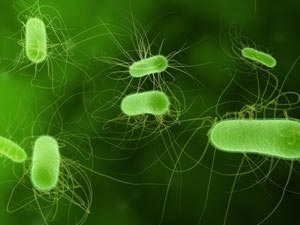Removing genes without a trace

A*STAR researchers have successfully deleted genes from Escherichia coli without leaving a scar. © Eraxion/iStock/Thinkstock
Genes may now be deleted without creating a scar in certain strains of Escherichia coli and other microorganisms, thanks to researchers at Agency for Science, Technology and Research (A*STAR) in Singapore [1]. The technique makes it easier to string together several genetic engineering steps without interference caused by a deletion scar.
Scientists currently delete genes by manipulating a process known as homologous recombination. Nucleotide sequences change places with the target gene during homologous recombination and are left behind as a genetic scar, undermining the effectiveness of subsequent deletions. As scars accumulate, the recombination process is more likely to recognize them than the target gene, disrupting the deletion attempt.
The scar-free deletion trick developed by Hua Zhao and colleagues at the A*STAR Institute of Chemical and Engineering Sciences utilizes a natural DNA repair mechanism. Gene duplication events or errors during replication occasionally lead to the formation of a mirrored DNA sequence known as an inverted repeat.
Since the repeated segments in an inverted repeat are complementary, they bind to each other and form a loop structure. While short loops have a biological role, longer loops can damage the genome and are therefore cut out by repair machinery.
“The key insight was the extreme instability of inverted repeats in the E. coli genome, which we and others observed. That prompted us to explore its application in gene deletion,” says Zhao.
To delete a gene, Zhao’s team prepares a DNA fragment, which includes an inverted repeat of part of the target gene. They then insert the fragment into the genome adjacent to the gene. The inverted repeats form a loop, and the repair machinery swoops in to snip them out. Since the repair process does not always happen, the team also engineers a selection marker into the fragment, enabling them to detect colonies in which it has been cut out.
Zhao’s team successfully repeated their method on three different E. coli genes. They also tested inverted repeats of different lengths to determine which worked best. While shorter repeats were less likely to be excised, longer repeats did not integrate into the genome as often.
Engineering E. coli to produce biochemicals often involves the deletion of multiple genes. According to Zhao, approaches presently only allow four genes to be deleted in sequence. “After that, further deletions create trouble because of recombination between the deletion scars. Our new method doesn’t introduce scars, so recombination won’t be a problem for multiple deletions.”
The A*STAR-affiliated researchers contributing to this research are from the Institute of Chemical and Engineering Sciences
Reference
[1] Tear, C. Y., Lim, C. & Zhao, H. Excision of unstable artificial gene-specific inverted repeats mediates scar-free gene deletions in Escherichia coli. Applied Biochemistry and Biotechnology 175, 1858–1867 (2015).
Associated links
Original article from A*STAR Research
Media Contact
More Information:
http://www.researchsea.comAll latest news from the category: Life Sciences and Chemistry
Articles and reports from the Life Sciences and chemistry area deal with applied and basic research into modern biology, chemistry and human medicine.
Valuable information can be found on a range of life sciences fields including bacteriology, biochemistry, bionics, bioinformatics, biophysics, biotechnology, genetics, geobotany, human biology, marine biology, microbiology, molecular biology, cellular biology, zoology, bioinorganic chemistry, microchemistry and environmental chemistry.
Newest articles

NASA: Mystery of life’s handedness deepens
The mystery of why life uses molecules with specific orientations has deepened with a NASA-funded discovery that RNA — a key molecule thought to have potentially held the instructions for…

What are the effects of historic lithium mining on water quality?
Study reveals low levels of common contaminants but high levels of other elements in waters associated with an abandoned lithium mine. Lithium ore and mining waste from a historic lithium…

Quantum-inspired design boosts efficiency of heat-to-electricity conversion
Rice engineers take unconventional route to improving thermophotovoltaic systems. Researchers at Rice University have found a new way to improve a key element of thermophotovoltaic (TPV) systems, which convert heat…



